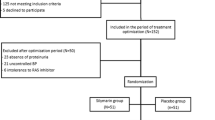Abstract
Background
The antiproteinuric pharmacokinetics of Ramipril in response to different doses and modalities of administration has been poorly investigated so far.
Study design
Prospective, open-label and not placebo controlled study.
Setting and participants
40 Caucasian adult patients having GFR ≥ 50 mL/min, proteinuria 1–3 g/day; SBP/DBP ≤ 150/90 mmHg were recruited between June 2014 and November 2014.
Factor and outcome
Impact on 24 h proteinuria and fractioned proteinuria of Ramipril given at different dosages (2.5 mg/day or Ramipril 5 mg/day or Ramipril 10 mg/day) and with different daily administration modalities (single or two divided doses) for cycles of 10 days.
Measurements
At the end of each cycle, 24 h and fractioned proteinuria on three timed urinary collections (morning, afternoon and night) were measured.
Results
Compared to baseline, Ramipril significantly reduced 24 h proteinuria at each dose and modality of administration. In particular, the greatest effects were evident with the higher and divided dose of the drug. The analysis of the fractioned proteinuria showed that the greatest reduction was obtained in the night urinary collection by administering Ramipril 10 mg/day in two divided doses.
Limitations
Small sample size.
Conclusions
Ramipril reduces proteinuria at any of the tested doses. Although the using of high and divided doses seems to maximize the antiproteinuric effect of the drug, possibly due to a better pharmacological coverage of the nocturnal period.



Similar content being viewed by others
References
Jafar TH, Stark PC, Schmid CH, Landa M, Maschio G, de Jong PE et al (2003) Progression of chronic kidney disease: the role of blood pressure control, proteinuria, and angiotensin converting enzyme inhibition: a patient-level meta-analysis. Ann Intern Med 139(4):244–252. doi:10.7326/0003-4819-139-4-200308190-00006
Cravedi P, Remuzzi G (2013) Pathophysiology of proteinuria and its value as an outcome measure in CKD. Br J Clin Pharmacol 76:516–523. doi:10.1111/bcp.12104
Ruggenenti P, Perna A, Mosconi L, Pisoni R, Remuzzi G (1998) Urinary protein excretion rate is the best independent predictor of ESRF in non-diabetic proteinuric chronic nephropathies. Gruppo Italiano di Studi Epidemiologici in Nefrologia (GISEN). Kidney Int 53(5):1209–1216. doi:10.1046/j.1523-1755.1998.00874.x
Hemmelgarn BR, Manns BJ, Lloyd A, James MT, Klarenbach S, Quinn RR et al (2010) Relation between kidney function, proteinuria, and adverse outcomes. JAMA 303(5):423–429. doi:10.1001/jama.2010.39
Simeoni M, Nicotera R, Colao M, Citraro ML, Pelagi E, Cerantonio A et al (2015) Direct inhibition of plasmatic renin activity with aliskiren: a promising but under-investigated therapeutic option for non-diabetic glomerulonephritis. Int Urolol Nephrol. doi:10.1007/s11255-015-1128-4
Ruggenenti P, Perna A, Gherardi G, Garini G, Zoccali C, Salvadori M et al (1999) Renoprotective properties of ACE-Inhibition in non-diabetic nephropathies with non-nephrotic proteinuria. Lancet 354(9176):359–364. doi:10.1016/S0140-6736(98)10363-X
Gansevoort RT, Sluiter WJ, Hemmelder MH, de Zeeuw D, de Jong PE (1995) Antiproteinuric effect of blood-pressure-lowering agents: a meta-analysis of comparative trials. Nephrol Dial Transplant 10(11):1963–1974
Gansevoort RT, de Zeeuw D, de Jong PE (1993) Dissociation between the course of the hemodynamic and antiproteinuric effects of angiotensin I converting enzyme inhibition. Kidney Int 44(3):579–584. doi:10.1038/ki.1993.284
Eijkelkamp WB, Zhang Z, Remuzzi G, Parving HH, Cooper ME, Keane WF et al (2007) Albuminuria is a target for renoprotective therapy independent from blood pressure in patients with type 2 diabetic nephropathy: post hoc analysis from the Reduction of Endpoints in NIDDM with the Angiotensin II Antagonist Losartan (RENAAL) trial. J Am Soc Nephrol 18(5):1540–1546. doi:10.1681/ASN.2006050445
Radhakrishnan J, Cattran DC (2012) The KDIGO practice guideline on glomerulonephritis: reading between the guidelines-application to the individual patient. Kidney Int 82(8):840–856. doi:10.1038/ki.2012.280
Taddei S, Bruno RM, Ghiadoni L (2011) The correct administration of antihypertensive drugs according to the principles of clinical pharmacology. Am J Cardiovasc Drugs 11(1):13–20. doi:10.2165/11586670-000000000-00000
Simeoni M, Cianfrone P, Comi N, Gentile I, Fabiano FF, Piraina V et al (2015) Is it feasible to improve the duration and the efficiency of Ramipril anti-proteinuric response? G Ital Nefrol 32(1)
Mancia G, Fagard R, Narkiewicz K et al (2013) ESH/ESC Guidelines for the management of arterial hypertension. J Hypertens 31(10):1925–1938. doi:10.3109/08037051.2013.812549
Levey AS, Stevens LA, Schmid CH et al (2009) A new equation to estimate glomerular filtration rate. Ann Intern Med 150(9):604–612. doi:10.7326/0003-4819-150-9-200905050-00006
Levitt DG, Schoemaker RC (2006) Human physiologically based pharmacokinetic model for ACE inhibitors: ramipril and ramiprilat. BMC Clin Pharmacol 6:1. doi:10.1186/1472-6904-6-1
Simeoni M, Cerantonio A, Pastore I, Liguori R, Greco M, Foti D et al (2015) The correct renal function evaluation in patients with thyroid dysfunction. J Endocrinol Invest. doi:10.1007/s40618-015-0402-8
Goncalves AR, Fujihara CK, Mattar AL et al (2004) Renal expression of COX-2, ANG II, and AT1 receptor in remnant kidney: strong renoprotection by therapy with losartan and a nonsteroidal anti-inflammatory. Am J Physiol Renal Physiol 286(5):F945–F954. doi:10.1152/ajprenal.00238
Benigni A, Tomasoni S, Gagliardini E et al (1046) 2001 Blocking angiotensin II synthesis/activity preserves glomerular nephrin in rats with severe nephrosis. J Am Soc Nephrol 12(5):941–948
Author information
Authors and Affiliations
Corresponding author
Ethics declarations
Conflict of interest
All authors have none conflict of interest to declare.
Ethical approval
All procedures performed on humans were in accordance with the ethical standards of the local Medical Ethics Committee (approval number: 2011/42) and with the 1964 Helsinki Declaration and its later amendments or comparable ethical standards.
Informed consent
Informed consent was obtained from all individual participants included in the study.
Rights and permissions
About this article
Cite this article
Cianfrone, P., Simeoni, M., Comi, N. et al. How to improve duration and efficiency of the antiproteinuric response to Ramipril: RamiPROT—a prospective cohort study. J Nephrol 30, 95–102 (2017). https://doi.org/10.1007/s40620-015-0256-3
Received:
Accepted:
Published:
Issue Date:
DOI: https://doi.org/10.1007/s40620-015-0256-3




